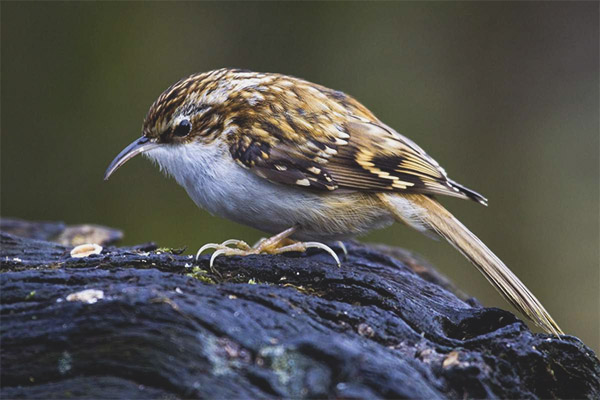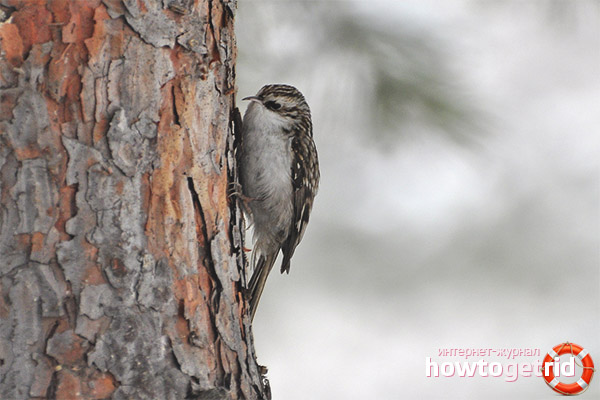The content of the article
An ordinary pika is understood as a miniature bird belonging to a passerine squad. A distinctive feature of these birds is the squeak, which they publish instead of tweeting. The individuals of this family are so small that in some cases people simply do not notice them. It is possible to note the movement of these individuals - spiral, vertical, along the trunk of a tree. Representatives of the family can look for food in the form of bugs and spiders for the whole day.
Description
- The bird belongs to the order of passerines and the family of pikas. In terms of dimensional features, the birds do not exceed 12 cm with a body weight of 10 grams. maximum. By constitution, they are rounded and miniature, the neck is rather short. The head is small in size, flattened on the sides.
- These birds are distinguished by their non-standard beak.It is thin, squeezed, elongated and pointed at the edge. According to external data, the beak is like a sharp sickle.
- The wings are average in size, in span they are 20 cm. The tail is elongated, narrowed, cut in a straight line on the edge. The legs are short, with four clawed toes.
- By plumage, these representatives of the family are voluminous. Feathers themselves loose, compacted. According to its plumage, the abdominal region is pigmented with white, as well as the lower part of the body. Pikuhi perfectly masked among the vegetation.
- Their upper body area is covered with brown feathers with brown specks. There are some variegated patches. With regard to differences in gender, females from males do not differ much.
- It is worth mentioning separately about the power of these members of the family. They eat various insects, as well as their larvae. They love to eat pupae, in the winter time they try to diversify their diet with vegetable food.
- They feed on seeds of coniferous trees. The individual receives almost the entire meal through the use of his beak. He will crawl into any cracks, and the bird can eat worms and bugs.
Nutrition and distribution
- The distribution of birds of the species of the species is quite diverse. In individuals of this category, there are interesting taste preferences, which may vary depending on the season and age. They live in the forest with deciduous trees. Constantly looking for food, exploring the bark of the tree with its sharp beak.
- Most often, these birds settle near rivers, where there are a lot of insects. Also found on lakes, in abandoned fruit or berry gardens, conifers (less often).
- Separate attention deserves the process of obtaining food. The bird with its entire body rests on a tree, using the tail. Then she puts her beak into the holes and tries to get insects. If the woodpecker is waiting for food to get into the mouth, then the pika spends strength and reaches the goal faster.
- Individuals of the breed group under discussion are very fond of bark beetles. Partly for this reason, birds are called forest healers. When spring begins and the autumn season ends, the birds already destroy a large number of pests that spoil the trees.
- If a bird finds trees rich in bugs, it will return to them every time. Will begin to examine the trunks from the bottom, gradually moving up. These individuals never go hungry, because from an early age they are endowed with the ability to get their own food.
- When the winter season comes, birds do not have the opportunity to eat various insects. They begin to lean on the fruits of coniferous trees, to get seeds.
Features of the form
- Birds practically do not fly, they can only move from one tree to another. Individuals cannot fly long distances. They prefer to settle on a tree and dwell on it all day.
- It is not necessary to take into account the fact that individuals prefer to roam in flocks. In everyday life, they still prefer to stay alone. Only when the cold comes, individuals gather in groups and warm themselves.
- It is interesting that these birds can be added to the titmouse and live with a flock of another species. Thus the birds survive the cold, they have more chances to survive.
- Pikuha belong to the territorial birds, which carefully guard the area where they live.They are trying to discourage outsiders from their spaces.
- A distinctive feature is that these birds are bold. They are not afraid of enemies, although at any time they can be eaten. Individuals are fearless and loyal to their family.
- When the winter period is approaching, all the birds fall into a lazy state. Then spring makes itself felt, individuals literally come alive. They begin to sing, they are looking for new trees to get food, they can go down the path behind a worm or bug.
- Earlier it was already mentioned that the birds get food, but at this time they rest their tail against the trunk of the tree. Therefore, their tail always looks battered, can be broken or frayed.
Breeding
- In the specimens presented, the mating season begins in early spring. It is worth noting that the males at this time most of all show aggression and constantly fight. As soon as skirmishes begin, they can be determined without any problems by a characteristic squeak.
- Since April, the birds are trying to equip the nest in the hollows of trees. Often the diameter of the entrance to the home can reach up to 40 cm.At the same time, the depth of the nest can be up to 30 cm. It is also worth noting that often the dwellings are located at a low distance from the ground.
- An interesting fact is that the construction of a nest in birds takes about half a month. Separately, it is worth mentioning that the upbringing of future offspring and the construction of housing rests entirely on the shoulders of the female.
- Most often, the individuals in question use the web, moss, their own fluff, lichen and twigs as a building material. Hardworking birds reinforce their nests from the side of the walls, and not the bottom of the hollow. It is for this reason that it can be said that the dwelling is just hanging inside the tree, and does not lie in it.
- Approximately at the beginning of May in the nests one can already notice the eggs of the specimens examined. It is worth noting that at this time the males are already completely silent. Over time, the female may well bring about 8 eggs. Most often they are white with red blotches.
- It often happens that clutch can be found at the beginning of summer. Such a factor mainly depends precisely on the climatic conditions and habitat of the individuals in question. Juveniles begin to spit up after half a month.
- Separately, it is worth noting that if the clutch was large, there is a possibility that several eggs will be lifeless. Also weakened chicks may suffer from larger brothers or from the parents themselves. Otherwise, adults try to feed the young in every way, constantly carrying food to them.
- As soon as the young grow stronger, the chicks begin to crawl along the tree. At the same time, they very tightly cling to the bark. As soon as the chicks notice the parents coming up, they begin to squeak very loudly. They also open their mouth wide while waiting for food.
- Often pikas try to breed two offspring in a row in one season. As previously mentioned, most factors depend precisely on the climatic conditions and habitat of the individuals in question. As soon as the chicks are on the wing, they try to settle near the parents.
Interesting Facts
- It is worth noting that during the singing of a bird two trills simultaneously emit. At the same time one of them is much higher than the second.
- When such birds move along a tree trunk, they use their own tail as a support.As a result, feathers are constantly erased and frown.
- In particularly cold times, birds can stray into small flocks in secluded places just to keep warm and not to die.
- Birds can often inhabit different forests. But in most cases, they choose ripe and old stands. In such places, they equip the nest and without any problems produce food.
The birds in question are often sedentary if they are allowed by climatic conditions. Only in some areas do individuals make small flights to warmer regions. As for the construction of nests, pikas build them in hollows and large cracks of trees.
Video: Common Pika (Certhia familiaris)













To send